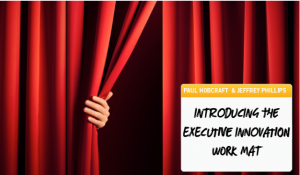When you begin to think through something that might change the present dynamics within innovation and its management it becomes exciting. When you develop an emerging answer, by recognizing one really critical gap that needs filling, it becomes hugely exciting actually.
Not just in researching it, in debating it but in eventually constructing a sound framework, that is visual, easy to connect too and for hopefully many to become involved and engaged with, brings this work together into a realization that is really rewarding.
For Jeffrey Phillips and me, we believe we are offering something that makes sense through our framework, which we call the Executive Innovation Work Mat, with a link to the short introductory series, published in September 2012.
In our initial White Paper there is the outlines of our thinking behind this Executive Innovation Work Mat. The important message is that we want to deliver the message into the boardrooms of as many business organizations as we can, with this message of intent which can be simply summed up as:
“we believe we have a framework that will help the leadership of organizations to identify with, understand their role in this and in this strategic participation and framing innovation intent, so advance the contribution of innovation within their organizations and beyond.”
Let me lay out the overarching proposition for this.

